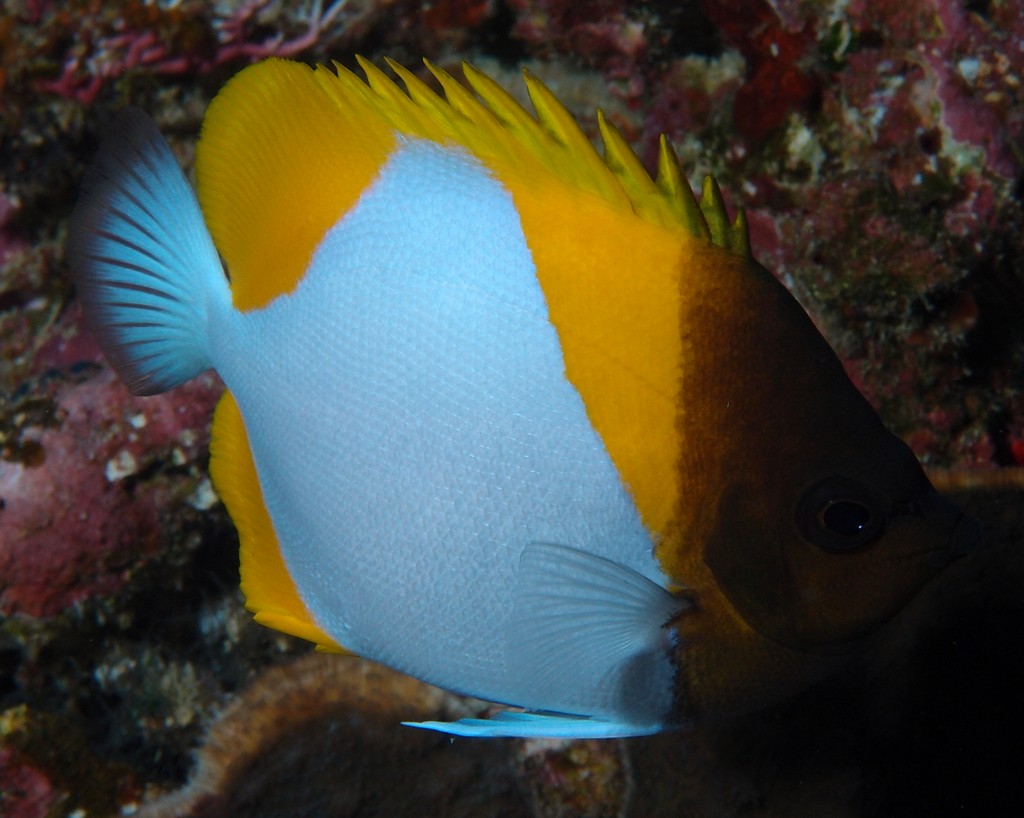HEMITAURICHTHYS POLYLEPIS - (BLEEKER, 1857)
Actinopterygii (Gigaclass) > Actinopteri (Class) > Teleostei (Subclass) > Acanthuriformes (Order) > Chaetodontidae (Family) > Heniochinae (Subfamily) > Hemitaurichthys (Genus)
Poisson-papillon pyramide jaune, Brushytoothed butterflyfish, Pyramid butterflyfish, Pyramid butterfly, Shy butterflyfish, Pyramidefanefisk, Kasumi-chôchô-uo, カスミチョウチョウウオ, 多鱗霞蝶魚, 霞蝶,
Synonyme
Chaetodon polylepis (Bleeker, 1857)
-------------------------
Description
Dorsal spines (total): 12; Dorsal soft rays (total): 23-26; Anal spines: 3; Anal soft rays: 19-23; Pectoral fin rays: 17-19; Lateral line scales: 68-74; Snout length: 2.6-2.8 in HL. Body depth: 1.5-1.6 in SL. Body is compressed laterally with a rounded body profile, and its snout protrudes forwards slightly with a small protrusible (extendable) mouth. Lateral line ending at middle of caudal fin base. Max. length: 18.0 cm TL. Depth range: 3 - 60 m.
Color
Dark brown-yellow area, the color of which may vary in intensity, fully masks the head and extends to a line from the first rays of the dorsal fin to the start of its pelvic fins. The rest of its body is white, peduncle and caudal fin included. Insertion of yellow-orange areas at the top of the side form a characteristic pyramidal pattern. The anal fin is also yellow-orange.
Etymology
Hemitaurichthys: from Greek, hemi = half + from Greek, taureia = skin of bull + from Greek, ichthys = fish. Originally referring to horn-like bony protuberances on head of Heniochus varius.
polylepis: from Latin, poly = many + from Latin, lepis = scale. Referring to numerous lateral-line scales (68-74), then considered the most of any of its presumed congeners in Chaetodon (original genus).
Original description: Chaetodon polylepis Bleeker, 1857 - Type locality: Ambon Island, Molucca Islands, Indonesia.
Distribution
Eastern Indian Ocean, western Pacific: Andaman Sea and Christmas Island (Indian Ocean) east to Hawaiian Islands, northern Line Islands and Pitcairn Group, north to southern Japan, south to Western Australia, Queensland (Australia), New Caledonia, Tonga and Austral Islands.
Biology
Occur in large schools that may extend several meters above the edges of steep current-swept outer reef slopes. Common. Benthopelagic. Feed on plankton. Oviparous. Form pairs during breeding. Aquarium fish (difficult).
Last update: 29, March 2023
Poisson-papillon pyramide jaune, Brushytoothed butterflyfish, Pyramid butterflyfish, Pyramid butterfly, Shy butterflyfish, Pyramidefanefisk, Kasumi-chôchô-uo, カスミチョウチョウウオ, 多鱗霞蝶魚, 霞蝶,
Synonyme
Chaetodon polylepis (Bleeker, 1857)
-------------------------
Description
Dorsal spines (total): 12; Dorsal soft rays (total): 23-26; Anal spines: 3; Anal soft rays: 19-23; Pectoral fin rays: 17-19; Lateral line scales: 68-74; Snout length: 2.6-2.8 in HL. Body depth: 1.5-1.6 in SL. Body is compressed laterally with a rounded body profile, and its snout protrudes forwards slightly with a small protrusible (extendable) mouth. Lateral line ending at middle of caudal fin base. Max. length: 18.0 cm TL. Depth range: 3 - 60 m.
Color
Dark brown-yellow area, the color of which may vary in intensity, fully masks the head and extends to a line from the first rays of the dorsal fin to the start of its pelvic fins. The rest of its body is white, peduncle and caudal fin included. Insertion of yellow-orange areas at the top of the side form a characteristic pyramidal pattern. The anal fin is also yellow-orange.
Etymology
Hemitaurichthys: from Greek, hemi = half + from Greek, taureia = skin of bull + from Greek, ichthys = fish. Originally referring to horn-like bony protuberances on head of Heniochus varius.
polylepis: from Latin, poly = many + from Latin, lepis = scale. Referring to numerous lateral-line scales (68-74), then considered the most of any of its presumed congeners in Chaetodon (original genus).
Original description: Chaetodon polylepis Bleeker, 1857 - Type locality: Ambon Island, Molucca Islands, Indonesia.
Distribution
Eastern Indian Ocean, western Pacific: Andaman Sea and Christmas Island (Indian Ocean) east to Hawaiian Islands, northern Line Islands and Pitcairn Group, north to southern Japan, south to Western Australia, Queensland (Australia), New Caledonia, Tonga and Austral Islands.
Biology
Occur in large schools that may extend several meters above the edges of steep current-swept outer reef slopes. Common. Benthopelagic. Feed on plankton. Oviparous. Form pairs during breeding. Aquarium fish (difficult).
Last update: 29, March 2023
